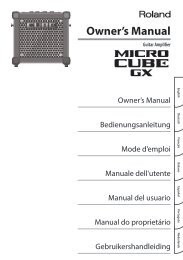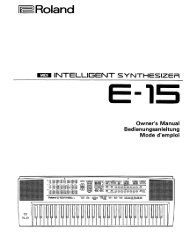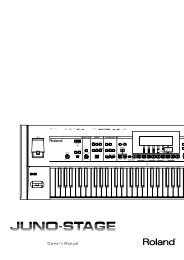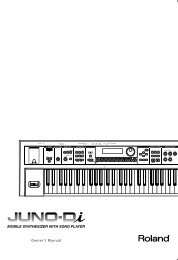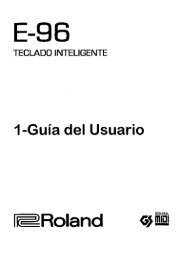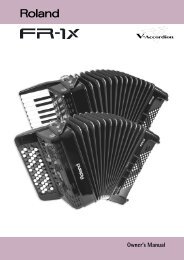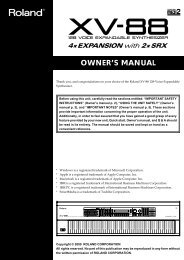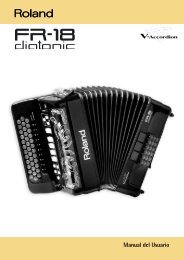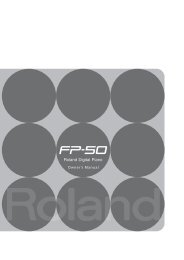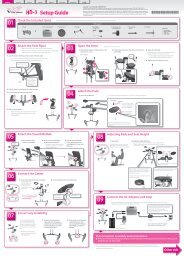Create successful ePaper yourself
Turn your PDF publications into a flip-book with our unique Google optimized e-Paper software.
Inputting notes<br />
Changing the location at which to input notes<br />
Turn [VALUE] to move to the next (previous) grid line.<br />
Hold down [HOLD] and turn [VALUE] to move in steps of a<br />
tick.<br />
When you reach the end of the measure, you will move to the<br />
next (previous) measure.<br />
Specifying the note to input<br />
Hold down a REC FUNCTION button [NOTE NUMBER]–<br />
[GATE TIME], and turn [VALUE], or move your finger<br />
horizontally on the D-FIELD to set the pitch/strength/length<br />
of the note that will be newly input.<br />
Operation Function Setting<br />
[NOTE NUM- Specify the pitch of C–(C-1)–G9<br />
BER]+[VALUE] the note.<br />
[VELOCI-<br />
Specify the strength 1–127<br />
TY]+[VALUE] (velocity) of the note.<br />
[NOTE<br />
Specify the time value 32, 16T, 16, 8T, 8,<br />
TYPE]+[VALUE] of the note.<br />
4T, 4, 2, 1<br />
[GATE<br />
Specify the length 5–200 (%)<br />
TIME]+[VALUE] (gate time) that the<br />
note will be held.<br />
* 1: 32 (32nd note), 16T (16th note triplets), 16 (16th note), 8T<br />
(8th note triplets), 8 (8th note), 4T (quarter note triplets), 4<br />
(quarter note), 2 (half note), 1 (whole note)<br />
Note settings for the D-FIELD<br />
Specify the note number, velocity, and gate time by moving<br />
your finger to left and right on the D-FIELD.<br />
The type of note can be specified by pressing the eight areas<br />
of the D-FIELD.<br />
Inputting/erasing notes<br />
No. Notes<br />
1 32 (32nd note)<br />
2 16T (16th note triplets)<br />
3 16 (16th note)<br />
4 8T (8th note triplets)<br />
5 8 (8th note)<br />
6 4T (quarter note triplets)<br />
7 4 (quarter note)<br />
8 2 (half note)<br />
When you press [ENTER], the note you specified using the<br />
REC FUNCTION buttons will be input at the current tick.<br />
If you press [EXIT (ERASE)], the note at the current tick will<br />
be erased.<br />
* Only notes specified by the REC FUNCTION [NOTE<br />
NUMBER] will be displayed.<br />
Chapter 6. Creating an Original Pattern<br />
Using the D-FIELD to enter notes<br />
During step recording, you can press the eight areas of the D-<br />
FIELD to record efficiently.<br />
fig.Pad<br />
No. Function Explanation<br />
1 REST Input a rest at the current tick and<br />
advance to the next tick.<br />
2 ENTER Input a note at the current tick and<br />
advance to the next tick.<br />
3 ERASE Erase the note at the current tick.<br />
4 TIE Extend the length of the most-recently<br />
input note by the amount of the<br />
current REC FUNCTION setting.<br />
5 PREV NOTE Move to the note of the same note<br />
number located immediately before<br />
the current tick.<br />
6 NEXT NOTE More to the note of the same note<br />
number located immediately after<br />
the current tick.<br />
7 SEARCH BWD Move to the note located immediately<br />
before the current tick, regardless<br />
of the note number.<br />
8 SEARCH FWD Move to the note located immediately<br />
after the current tick, regardless of<br />
the note number.<br />
Part editing while carrying out step<br />
recording<br />
If you perform part edit operations during step recording,<br />
the part settings will be modified, but the edit operations will<br />
not be recorded.<br />
63<br />
Chapter 6



